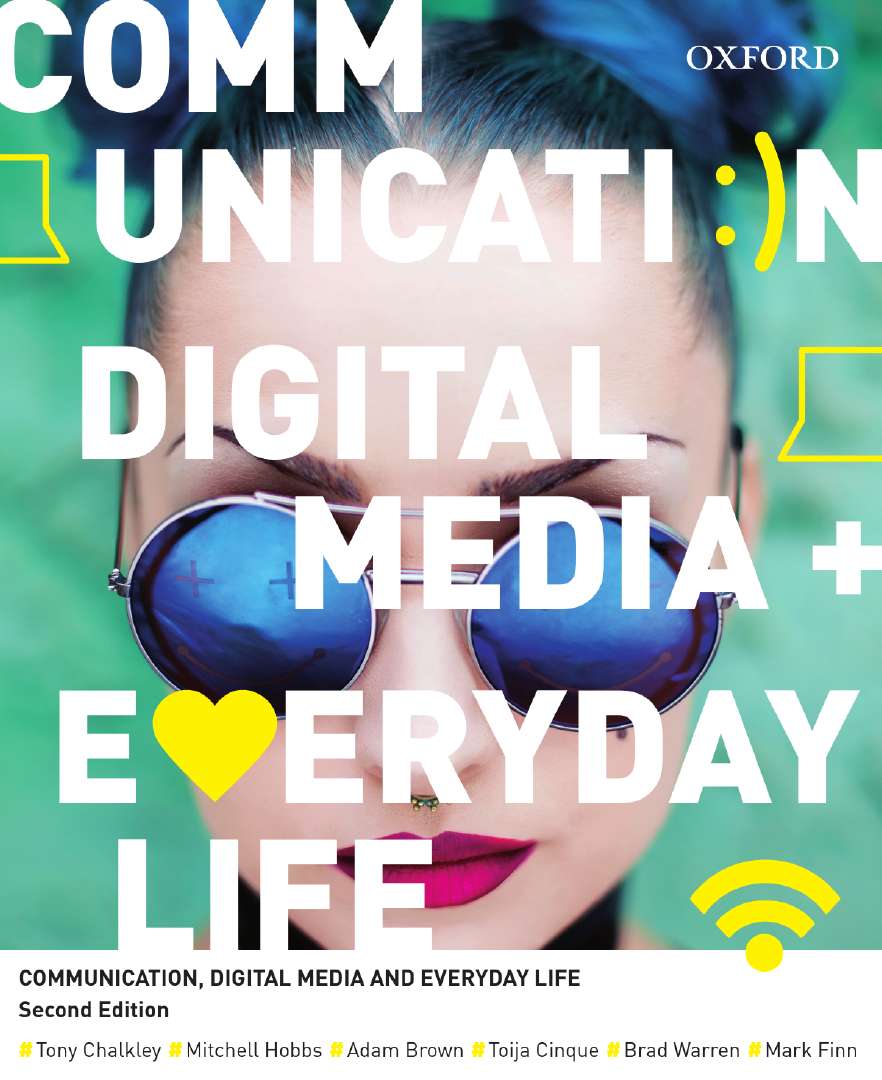PART 1: MEDIA AND SOCIETY
1. Introduction
2. What Is the Media, and Is Digital Media ‘New’?
Introduction
What exactly is ‘media’, and what does it mean to us?
What is digital or ‘new’ media?
What is ‘new’ in new media?
New media issues
3. Subtext and Mass Media
Introduction
Ideology and the media: Is what we see and hear on TV real?
The public (service) broadcasting model
The commercial model
From broadcast to multicast: Now anyone anywhere can have a say
4. Media Power and Influence
Introduction: A fractured window on reality
Don’t panic: media, violence and vice
Dimensions of media power
Conclusion
5. Making Meaning through Narrative: Conventions, Intertextuality and Transmedia Storytelling
Introduction
The stories of our lives: ‘All the world’s a stage’
The meaning of noise
Intertextuality and meaning-making: Connected through texts
Transmedia storytelling: Making narratives across platforms
6. Non-verbal Communication
Introduction
Object communication: We all want to belong to a group
Non-verbal communication: Eye contact, posture and sound
Gestures and ‘emblems’: How do we use emblems to communicate?
Emoticons r gr8t :-D
Conclusion: How hard is it to make a realistic humanoid robot?
7. Gender and Communication
Introduction
Meta-messages: ‘You’re not wearing that, are you?’
Bestsellers about gender: Are men and women really from different planets?
New media and gender: What happens in the virtual world?
Conclusion
8. Designing Desire: Advertising, Consumption and Identity
Introduction: ‘I shop, therefore I am’
Advertising: A short introduction
Advertising and the meaning of ‘stuff’
Commodities, culture and advertisements
Conclusion: Advertising and its relationship to consumption
9. Semiotics
Introduction: The ‘study of signs’
A short history of semiotics
The components of ‘the sign’
Beyond the surface: Denotation, connotation and myth
Reality and the sign: Content versus perspective
Conclusion: Semiotics for life
10. Online Dating
Introduction
Dating 101
Finding love: How hard can it be?
Online dating
Online motivations
Some student stories (and a little bit of theory)
11. Postmodernism
Introduction
The modern–postmodern shift (or plummet)
A logical approach to postmodernism: The question of origins
You have to ‘get’ modernism first
Postmodernism defined
Hyperreal expectations
Baudrillard’s simulacra
Jameson’s pastiche and Lévi-Strauss’s bricolage
A conclusion (of sorts)
PART 2: CONTENT AND CULTURE
12. Reading Film: Techniques, Identification and Ideology
Introduction: Simply a story or something beneath the surface?
The construction of meaning in film: Defining ideology
Framing our emotions and affecting our ideas: ‘But I love them; they can’t die!’
A ‘visual grammar’: Film and the tools of meaning-making
Gendered power relations in The Castle: ‘A man’s house is his castle’
13. Organisational and Professional Communication
Introduction
What exactly is organisational communication?
Digital or mediated communication: The modern world of organisational communication
A brief history of organisations and communication
Models help us understand the complexity of communication
Uniforms: What do they ‘say’?
Conclusion
14. Values, Ideals and Power in the Brave New Digital World
Introduction
Internet innovation and cyber-libertarian values to swift marketisation
The true cost of free: Behavioural marketing, social networking and privacy
Social networks: Size does matter
So what do we need in internet policy?
PART 3: COMMUNICATION
15. Constructed Reality
Introduction: ‘Let’s go phishing!’
Data mining—phishing’s semi-respectable cousin
Security, naivety and life online
The increasing irrelevance of the online/offline distinction
To play or not to play: Looking for love online
Types of play: Paidia and ludus (or tales of the sandpit)
Facebook, online forums and (declining?) literacy
Denotation and connotation
The techno-legal time-gap
16. Navigating Social Media: Identity, Privacy and Performativity in the Digital Age
Introduction
Online communities: What is social media and what is it for?
‘Identity’ in everyday life: Profiling our selves
Gaining or losing control: ‘Get out of my face, stay out of my space!’
Adopting social media in the public sphere: Poke a politician
Performing online: The impact of celebrity culture
17. Games, Culture and Technology
Introduction: Mapping the terrain
Studying gamer culture
Emerging trends in games and games research
Social gaming and the gamification of everything
18. Technology, Piracy, Creativity and Ownership
Introduction
Genealogy: A simple metaphor
Mechanical invention: The printing press, books and the PC
Software development: From analogue to digital
Social change: Adoption, adaptation and then dependence
The motivation to pirate
Plagiarism: Ease, speed and pressure
Conclusion
19. Surveillance
Introduction
The panopticon
(How) Do we live in a surveillance society?
‘Big Brother’ gives way to lots of ‘Little Brothers’?
Prisons, CCTV, data mining, cashless canteens and now Facebook
Has surveillance been normalised?
20. Reality TV and Constructed Reality
Introduction
Reality television: Learning to discourse
What do you meme?
(Cultural) Hegemony
Stuart Hall and encoding/decoding: do not go quietly
Revisiting the prison: Foucault, the panopticon and Big Brother
21. Conclusion: Do We Communicate ‘Less’ or ‘More’ in the Digital Age?
Tony Chalkley: Senior Lecturer, School of Communication & Creative Arts, Deakin University
Mitchell Hobbs: Lecturer, Department of Media and Communications, University of Sydney
Adam Brown: Senior Lecturer, School of Communication & Creative Arts, Deakin University
Toija Cinque: Senior Lecturer, School of Communication & Creative Arts, Deakin University
Brad Warren: Contract Lecturer and Research Consultant, School of Communication & Creative Arts, Deakin University
Mark Finn: Senior Lecturer, School of Arts, Social Sciences and Humanities, Swinburne University

